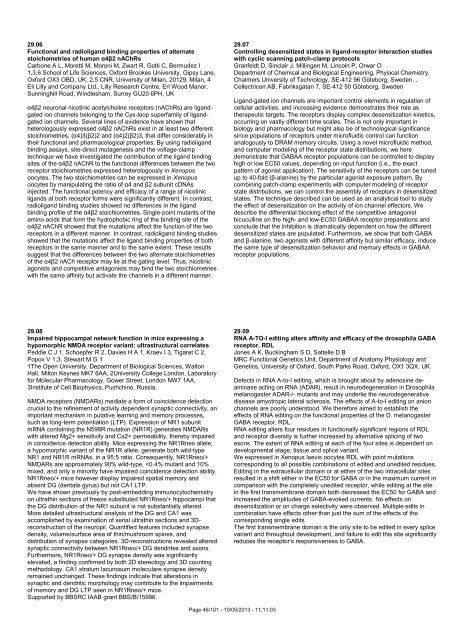Book of abstracts - British Neuroscience Association
Book of abstracts - British Neuroscience Association
Book of abstracts - British Neuroscience Association
You also want an ePaper? Increase the reach of your titles
YUMPU automatically turns print PDFs into web optimized ePapers that Google loves.
29.06<br />
Functional and radioligand binding properties <strong>of</strong> alternate<br />
stoichometries <strong>of</strong> human α4β2 nAChRs<br />
Carbone A L, Moretti M, Moroni M, Zwart R, Gotti C, Bermudez I<br />
1,3,6 School <strong>of</strong> Life Sciences, Oxford Brookes University, Gipsy Lane,<br />
Oxford OX3 OBD, UK, 2,5 CNR, University <strong>of</strong> Milan, 20129, Milan, 4<br />
Eli Lilly and Company Ltd., Lilly Research Centre, Erl Wood Manor,<br />
Sunninghill Road, Windlesham, Surrey GU20 6PH, UK<br />
α4β2 neuronal nicotinic acetylcholine receptors (nAChRs) are ligandgated<br />
ion channels belonging to the Cys-loop superfamily <strong>of</strong> ligandgated<br />
ion channels. Several lines <strong>of</strong> evidence have shown that<br />
heterologously expressed α4β2 nAChRs exist in at least two different<br />
stoichiometries, (α4)3(β2)2 and (α4)2(β2)3, that differ considerably in<br />
their functional and pharmacological properties. By using radioligand<br />
binding assays, site-direct mutagenesis and the voltage-clamp<br />
technique we have investigated the contribution <strong>of</strong> the ligand binding<br />
sites <strong>of</strong> the α4β2 nAChR to the functional differences between the two<br />
receptor stoichiometries expressed heterologously in Xenopus<br />
oocytes. The two stoichiometries can be expressed in Xenopus<br />
oocytes by manipulating the ratio <strong>of</strong> α4 and β2 subunit cDNAs<br />
injected. The functional potency and efficacy <strong>of</strong> a range <strong>of</strong> nicotinic<br />
ligands at both receptor forms were significantly different. In contrast,<br />
radioligand binding studies showed no differences in the ligand<br />
binding pr<strong>of</strong>ile <strong>of</strong> the α4β2 stoichiometries. Single-point mutants <strong>of</strong> the<br />
amino acids that form the hydrophobic ring <strong>of</strong> the binding site <strong>of</strong> the<br />
α4β2 nAChR showed that the mutations affect the function <strong>of</strong> the two<br />
receptors in a different manner. In contrast, radioligand binding studies<br />
showed that the mutations affect the ligand binding properties <strong>of</strong> both<br />
receptors in the same manner and to the same extent. These results<br />
suggest that the differences between the two alternate stoichiometries<br />
<strong>of</strong> the α4β2 nACh receptor may lie at the gating level. Thus, nicotinic<br />
agonists and competitive antagonists may bind the two stoichiometries<br />
with the same affinity but activate the channels in a different manner.<br />
29.07<br />
Controlling desensitized states in ligand-receptor interaction studies<br />
with cyclic scanning patch-clamp protocols<br />
Granfeldt D, Sinclair J, Millingen M, Lincoln P, Orwar O<br />
Department <strong>of</strong> Chemical and Biological Engineering, Physical Chemistry,<br />
Chalmers University <strong>of</strong> Technology, SE-412 96 Göteborg, Sweden, ,<br />
Cellectricon AB, Fabriksgatan 7, SE-412 50 Göteborg, Sweden<br />
Ligand-gated ion channels are important control elements in regulation <strong>of</strong><br />
cellular activities, and increasing evidence demonstrates their role as<br />
therapeutic targets. The receptors display complex desensitization kinetics,<br />
occurring on vastly different time scales. This is not only important in<br />
biology and pharmacology but might also be <strong>of</strong> technological significance<br />
since populations <strong>of</strong> receptors under micr<strong>of</strong>luidic control can function<br />
analogously to DRAM memory circuits. Using a novel micr<strong>of</strong>luidic method,<br />
and computer modeling <strong>of</strong> the receptor state distributions, we here<br />
demonstrate that GABAA receptor populations can be controlled to display<br />
high or low EC50 values, depending on input function (i.e., the exact<br />
pattern <strong>of</strong> agonist application). The sensitivity <strong>of</strong> the receptors can be tuned<br />
up to 40-fold (β-alanine) by the particular agonist exposure pattern. By<br />
combining patch-clamp experiments with computer modeling <strong>of</strong> receptor<br />
state distributions, we can control the assembly <strong>of</strong> receptors in desensitized<br />
states. The technique described can be used as an analytical tool to study<br />
the effect <strong>of</strong> desensitization on the activity <strong>of</strong> ion channel effectors. We<br />
describe the differential blocking effect <strong>of</strong> the competitive antagonist<br />
bicuculline on the high- and low-EC50 GABAA receptor preparations and<br />
conclude that the inhibition is dramatically dependent on how the different<br />
desensitized states are populated. Furthermore, we show that both GABA<br />
and β-alanine, two agonists with different affinity but similar efficacy, induce<br />
the same type <strong>of</strong> desensitization behavior and memory effects in GABAA<br />
receptor populations.<br />
29.08<br />
Impaired hippocampal network function in mice expressing a<br />
hypomorphic NMDA receptor variant: ultrastructural correlates<br />
Peddie C J 1, Schoepfer R 2, Davies H A 1, Kraev I 3, Tigaret C 2,<br />
Popov V 1,3, Stewart M G 1<br />
1The Open University, Department <strong>of</strong> Biological Sciences, Walton<br />
Hall, Milton Keynes MK7 6AA, 2University College London, Laboratory<br />
for Molecular Pharmacology, Gower Street, London NW7 1AA,<br />
3Institute <strong>of</strong> Cell Biophysics, Pushchino, Russia,<br />
NMDA receptors (NMDARs) mediate a form <strong>of</strong> coincidence detection<br />
crucial to the refinement <strong>of</strong> activity dependent synaptic connectivity, an<br />
important mechanism in putative learning and memory processes,<br />
such as long-term potentiation (LTP). Expression <strong>of</strong> NR1 subunit<br />
mRNA containing the N598R mutation (NR1R) generates NMDARs<br />
with altered Mg2+ sensitivity and Ca2+ permeability, thereby impaired<br />
in coincidence detection ability. Mice expressing the NR1Rneo allele,<br />
a hypomorphic variant <strong>of</strong> the NR1R allele, generate both wild-type<br />
NR1 and NR1R mRNAs, in a 95:5 ratio. Consequently, NR1Rneo/+<br />
NMDARs are approximately 90% wild-type,
















